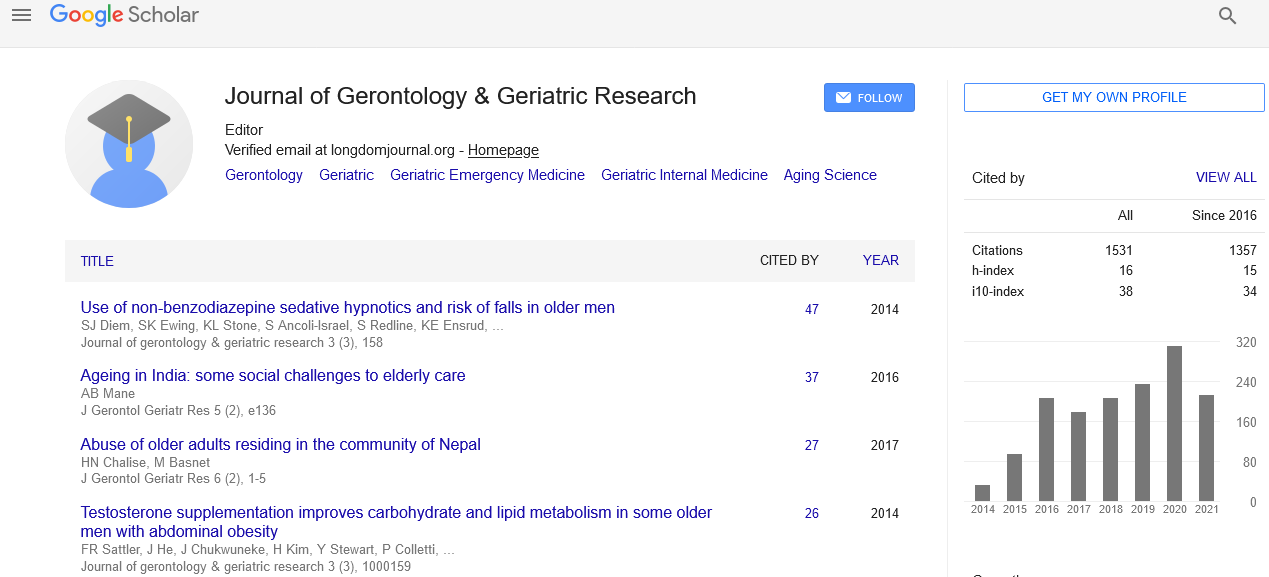PMC/PubMed Indexed Articles
Indexed In
- Open J Gate
- Genamics JournalSeek
- SafetyLit
- RefSeek
- Hamdard University
- EBSCO A-Z
- OCLC- WorldCat
- Publons
- Geneva Foundation for Medical Education and Research
- Euro Pub
- Google Scholar
Useful Links
Share This Page
Journal Flyer

Open Access Journals
- Agri and Aquaculture
- Biochemistry
- Bioinformatics & Systems Biology
- Business & Management
- Chemistry
- Clinical Sciences
- Engineering
- Food & Nutrition
- General Science
- Genetics & Molecular Biology
- Immunology & Microbiology
- Medical Sciences
- Neuroscience & Psychology
- Nursing & Health Care
- Pharmaceutical Sciences
Dental implant associated to removable partial denture: Benefits for elderly patients
International Conference on Geriatrics & Gerontology
July 08-10, 2014 DoubleTree by Hilton Hotel Chicago-North Shore Conference Center, USA
Piero Rocha Zanardi, Roberto Chaib Stegun, Newton Sesma, Bruno Costa and Dalva Cruz Lagan
Scientific Tracks Abstracts: J Gerontol Geriat Res
Abstract:
Introduction: Early tooth loss may lead to a severe ridge resorption and is an important issue that can be mandatory in the treatment planning, mainly in the elderly patient?s rehabilitation. The removable partial denture (RPD) may be the elective treatment for partial edentulous patients presenting low alveolar ridge height and also presents financial benefits when compared to implant-supported fixed prosthesis. The continuous improvement of implant dentistry and with the statement of high success rate for short implants, new types of treatment become practicable. Association of RPD with short dental implants seems to improve general dental health care, especially for elderly patients. Objective: This study reports the planning, prosthetic maintenance and mechanical improvement of RPD associated to strategic positioned implants for partially edentulous elderly patients Case report. Three patients 1 male (67 years) and 2 females (64, 69 years) with a partially edentulous arch are described in this report. The implant surgery planning was made with the intention of promoting biomechanics benefits, by inserting the implants according to strategic positions, where one or two implants were placed to promote symmetrical support or retention. The patients were classified as Class I or II of Kennedy. For the two Class I patients the implants placement were beneath the distal extension base of the RPD. In latter patients, the lack of ridge height requested short implants with 5 mm length. For the Class II of Kennedy patient, one implant was placed in the canine position. The surgical procedure was made by the flapless technique after the verification of sufficient bone volume through a CT-Scan. The prosthetic procedure differs only by avoiding the implant area with the metallic structure to facilitate the attachment capture. An o?ring attachment was used for the three related patients. Conclusion: Placement of implants in strategic sites, associated to RPD distal extension base improved functional comfort and stability. This alternative treatment may improve oral condition especially for elderly patients.
Biography :
Piero Rocha Zanardi has completed his MSc in 2012 from School of Dentistry in the University of S?o Paulo and currently he is a PhD student at the same institution. He is member of ITI (International Team of Implantology) and ECPI-FOUSP (Excellence Center in Prosthesis and Implant of the School of Dentistry, University of S?o Paulo, Brazil). He is editorial board member from Journal of Dentistry and Clinical Research. His research area includes dental implants and removable partial denture.


